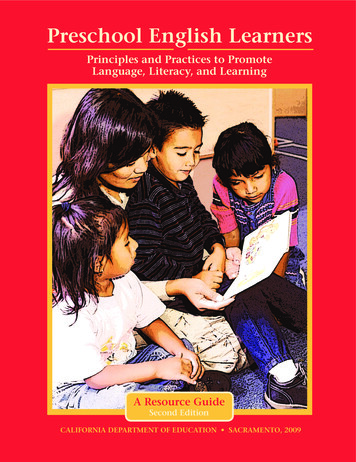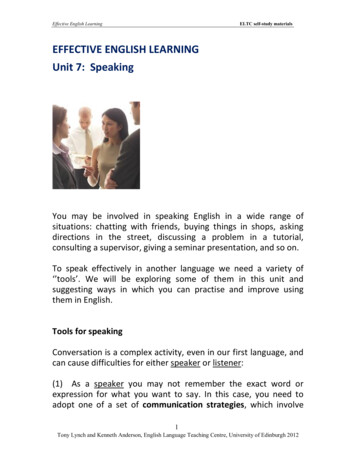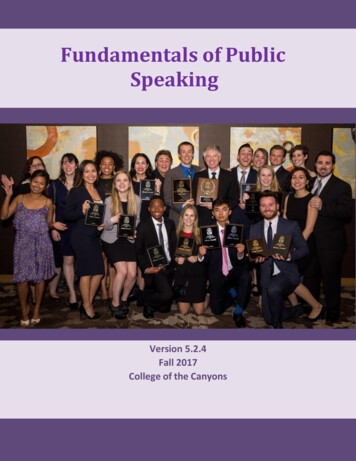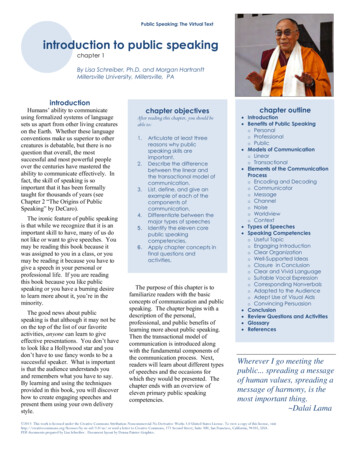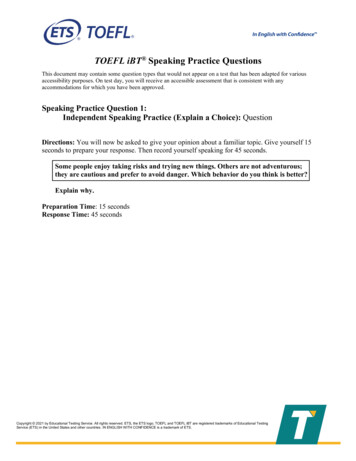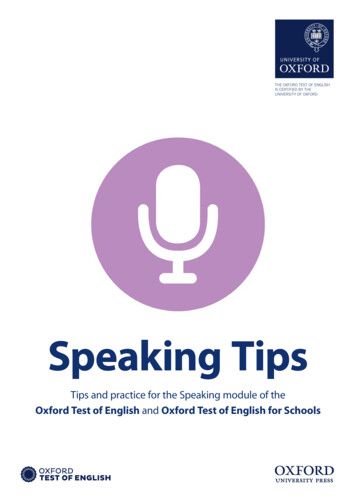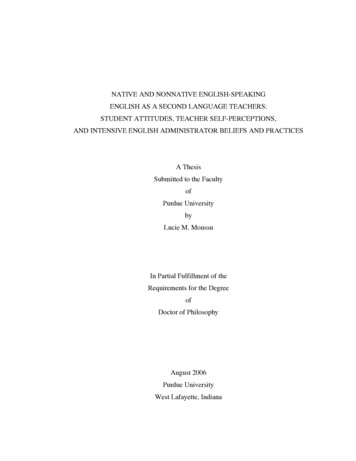
Transcription
NATIVE AND NONNATIVE ENGLISH-SPEAKINGENGLISH AS A SECOND LANGUAGE TEACHERS:STUDENT ATTITUDES, TEACHER SELF-PERCEPTIONS,AND INTENSIVE ENGLISH ADMINISTRATOR BELIEFS AND PRACTICESA ThesisSubmitted to the FacultyofPurdue UniversitybyLucie M. MoussuIn Partial Fulfillment of theRequirements for the DegreeofDoctor of PhilosophyAugust 2006Purdue UniversityWest Lafayette, Indiana
iiACKNOWLEDGEMENTSI would like to thank with all my heart all the people who have helped me makethis research project a success: Margie Berns, my dear advisor and dissertation Chair,who has guided me and encouraged me with great energy and endless faith in myabilities; the members of my dissertation committee, Irwin Weiser, Tony Silva, andShirley Rose, whose useful suggestions and encouragements were much appreciated;George Braine, Lia Kamhi-Stein, Paul and Aya Matsuda, and Ahmar Mahboob, whoinspired this dissertation and whose invaluable feedback kept me going in the rightdirection; the many Intensive English Program administrators (and their secretaries!) whograciously participated in this project and gave me their time, paid for photocopies,helped with the IRB forms, encouraged their teachers and students to participate, andbelieved in the importance of this project; the hundreds of ESL teachers and students whocontributed to this project one way or another and gave me priceless responses; VeronicaRicol, whose sense of organization, patience, and endless humor allowed us to enter,analyze, and file thousands of questionnaires; the many colleagues, teachers, and friendswho helped with pilot studies, translations, and back translations for countless hours;Reeshad Dalal and Duane Wegener from Purdue’s Psychology Department, whom I cannever thank enough for their amazing support; Purdue’s Statistical consultants, whoseguidance allowed me to calculate numerous volumes of statistical results; theInternational Foundation for English Language Education (TIRF), which funded thisproject entirely with a generous Doctoral Dissertation Grant; my family, who neverdoubted I would really finish school one day; every person at Purdue and elsewhere whoshared suggestions, reassurance, or a word (or more) of encouragement; and finally,someone special, who has guided me wisely and has been with me through all the upsand downs of my life with his humor and love. To all of you, thank you! I could not havemade it this far without you.
iiiTABLE OF CONTENTSPageGLOSSARYivABSTRACTviiiCHAPTER ONE: INTRODUCTIONStatement of the ProblemPersonal PerspectiveTheoretical Assumptions and DiscussionsGoals of the Research Project and Research QuestionsSignificance of the ProjectSummary1257101213CHAPTER TWO: REVIEW OF LITERATUREInternational Teaching AssistantsTeacher EducationESL and EFL Teachers’ PerspectivesAdvantages and Disadvantages of NESTs and NNESTsTeachers’ Self-perceptionsWhat is a “Qualified” Teacher?IEP Administrators’ PerspectivesBackground Information about IEPsBeliefs and Hiring PracticesESL and EFL Students’ PerspectivesDefinition of AttitudeResearch Studies with TER 3: METHODOLOGYResearch DesignInstrumentsRationale for Using QuestionnairesConstructs4242444447
ivPageDescription of the QuestionnairesFirst PilotAnalysis and RevisionsSecond PilotRevisionsData Collection ProceduresAnalysis of the DataParticipantsIntensive English ProgramsAdministrator, Teacher, and Student DemographicsStudent Demographics by SchoolConclusionCHAPTER FOUR: STUDENTS’ INITIAL ATTITUDESTeacher AppreciationPhysical AppearanceGrammarPronunciationFinal 80818386CHAPTER FIVE: INFLUENCE OF VARIABLESStudents’ First LanguageGenderClass SubjectLevelExpected GradeTeachers’ First LanguageConclusion88889497102105110114CHAPTER SIX: INFLUENCE OF TIMEOverall PatternsTeacher AppreciationRole Model and Physical AppearanceGrammarPronunciationFinal StatementsConclusion116117118120122124127131
vPageCHAPTER SEVEN: TEACHERS AND ADMINISTRATORSDiscrimination and Response to DiscriminationTeachers’ Self-PerceptionsNNESTs’ StrengthsNNESTs’ WeaknessesInstruction Aimed at NNESTs or About NNESTsPreparation for Teaching AssignmentsOverall Teachers and Administrators’ AttitudesIEP Administrators’ Beliefs and PracticesFinal 1CHAPTER EIGHT: DISCUSSION AND CONCLUSIONStudents’ Initial AttitudesInfluence of VariablesInfluence of TimeTeachers’ Self-PerceptionsIEP Administrators’ Beliefs and PracticesImplications and Future StudiesRecommendationsTeacher Education ProgramsIntensive English ProgramsDelimitations and LimitationsDelimitationsTechnical 7178179180183REFERENCES184APPENDICESAppendix A: Project FlowchartAppendix B: First Pilot Student QuestionnaireAppendix C: Second Pilot Student QuestionnaireAppendix D: Student QuestionnaireAppendix E: Teacher QuestionnaireAppendix F: Administrator QuestionnaireAppendix G: Directions for DistributionAppendix H: Individual School DataAppendix J: Attitudes at the Beginning of the Semester (Means)Appendix K: Attitudes at the Beginning of the Semester (Frequencies)196197199202205207209210216218
viPageAppendix L: Responses by VariablesStudents’ First languageGenderClass SubjectClass LevelStudents’ Expected GradeTeachers’ First LanguageAppendix M: Description of Gingko’s Levels of ProficiencyAppendix N: Attitudes at the End of the Semester (Means)Appendix P: Attitudes at the End of the Semester (Frequencies)Appendix Q: T-TestsAppendix R: New TESOL Resolution on 7303304
viiGLOSSARYThe following acronyms and terms will be used in this dissertation and need someclarification. While some terms are easily defined, others are more complex and can haveseveral interpretations according to different linguistic or sociolinguistic perspectives.EFL: English as a Foreign Language. English taught in non-English-speakingcountries such as Venezuela, France, or China. The distinction between ESL and EFL isnot always clear, especially in multilingual countries. Kachru’s (1982) model of innercircle, outer circle, and expending circle Englishes would probably place EFL in theexpending circle.ESL: English as a Second Language. English taught to international students orimmigrants in English-speaking countries such as the United States, England, Australia,or Canada. Again, the distinction can be problematic in outer circle countries (Kachru)such as India or Kenya.IEP: Intensive English Program. An ESL school where young adults and adultsfrom all over the world study English. Most students in IEPs are on a F-1 (full-timestudent) visa. IEPs usually offer language programs speakers of all levels of English,from beginners to advanced. These programs can be independent or attached to acommunity college or university, and often offer college preparation classes.ITA: International Teaching Assistants. International graduate students in NorthAmerican universities who have teaching assistantships.NAFSA: National Association for Foreign Student Affairs, known today asNAFSA: Association of International Educators. This association provides support andresources to directors of international student and scholar offices at universities, as wellas IEP directors. Created after NAFSA were such associations as the UCIEP (consortiumof University and College Intensive English Programs), the AAIEP (AmericanAssociation of Intensive English Programs), the ACCET (Accrediting Council for
viiiContinuing Education & Training), and the CEA (Commission on English LanguageProgram Accreditation). These associations provide accreditation (standards andprofessional recognition) to IEPs.NEST: Native English-Speaking ESL/EFL Teacher. An ESL/EFL teacher whosefirst language is English. (This definition seems to be widely accepted today, but hasmeant, in the past, that the teacher spoke natively the first language of the EFL students,as for example, in Edge’s (1988) article).NNEST: Non-Native English-Speaking ESL/EFL Teacher. An ESL/EFL teacherwhose first language is not English. In EFL settings, the NNESTs’ first language is oftenthat of the EFL students.NNS: Non-Native Speaker (of English, in this case). Someone who has learned alanguage other than English as a first language, and is learning or has learned English asan additional language.NS: Native Speaker (of English, in this case). Someone whose main or firstlanguage is English and who has learned it first as a child. As will be discussed later,these definitions are vague and highly contested, and the distinction between NS andNNS is often problematic.TESOL: Teachers of English (or Teaching English) to Speakers of OtherLanguages or Teaching English as a Second or Other Language. This acronym candescribe three things: 1) the international professional organization, created in 1966, ofESL and EFL teachers. TESOL includes different Interest Sections (IS) such as the IEPIS, or the Higher Education IS, as well as different caucuses, such as the NonnativeEnglish Speakers in TESOL caucus; 2) the teaching and research field, sometimes alsocalled TESL; and 3) the educational program and qualification (MA TESOL, forexample).TOEFL: Test of English as a Foreign Language. An examination administered byETS (Educational Testing Services) many foreign students must take before they areadmitted to North American universities and colleges. The TOEFL exam is somehowsimilar to the TOEIC (Test of English for International Communication), the MichiganEducational Assessment Program, or the Cambridge English Examinations.
ixABSTRACTMoussu, Lucie M. Ph.D., Purdue University, August, 2006. Native and NonnativeEnglish-Speaking English as a Second Language Teachers: Student Attitudes, TeacherSelf-perceptions, and Intensive English Administrator Beliefs and Practices. MajorProfessor: Margie Berns.The number of learners of English as an international means of communicationincreases hand in hand with the number of nonnative English-speaking teachers(NNESTs) of English as a Second Language (ESL) and the number of Native EnglishSpeaking ESL teachers (NESTs). At the same time, scholars (Kamhi-Stein, 1999; Liu,1999; Llurda, 2005) have estimated non-native English speakers to account for 40% to70% of the North-American student teacher population. However, few studiesinvestigated the working conditions of NESTs and NNESTs at Intensive EnglishPrograms (IEP) and the different factors that affect their successes and challenges. Thisresearch project thus investigates 1040 ESL students’ attitudes towards NESTs andNNESTs, the variables (students’ first languages, gender, class subject, level, andexpected grade, as well as teachers’ native languages) that influenced students’responses, and the effects of time on students’ attitudes, with questionnaires completedboth at the beginning and at the end of the fall 2005 semester. Online questionnaires alsosolicited 18 NNESTs and 78 NESTs’ self-perceptions about proficiency and teachingskills, as well as 21 IEP administrators’ beliefs about, and experiences with NNESTs andNESTs. Results showed that overall, students’ attitudes were more positive towardsNESTs than towards NNESTs, although students taught by NNESTs held a significantlymore positive attitude towards NNESTs in general than students taught by NESTs.Positive attitude towards NESTs and NNESTs increased significantly with time andexposure. Results also showed that students and teachers’ first languages, among others,strongly influenced students’ responses. Additionally, NNESTs were not necessarily seen
xas grammar experts but could be esteemed Listening/Speaking teachers. Teachers’responses revealed NNESTs’ lack of confidence in their linguistic and teaching skills butalso their beliefs that NNESTs’ language learning experience was an asset for ESLstudents. Finally, administrators also recognized NNESTs’ strengths as well as their poorself-confidence. While they did not use nativeness as hiring criteria, they emphasized theimportance of linguistics preparation and international awareness, as well as teachingexperience.
1CHAPTER ONEINTRODUCTIONOn October 9, 2004, these two job offers were found in the Chronicle of HigherEducation website (italics added):1) Position: ESL (English as a Second Language) Instructors. Location: Colorado.Semester-long and yearlong ESL teaching positions are available for the springsemester of 2005 [ ]. Any college graduate or student (native English speakersonly) may apply (http://chronicle.com/jobs/id.php?id 301227);2) Position: Assistant Professor, Department of English Language & Literature.Location: United Arab Emirates. Have a Ph.D. in ESP [English for SpecialPurposes] from a recognized British or American University. Have a minimum of3 years' full-time experience in teaching ESP [ ]. Be a native speaker of English(http://chronicle.com/jobs/id.php?id 303991).On October 9, 2004, too, I took a quick look at the first 10 job offers (on a list of401 offers) on Dave’s ESL Café (http://www.eslcafe.com/joblist/), a website growing insize and popularity, offering a wide range of information to ESL and English as a ForeignLanguage (EFL) teachers and students. That day, seven of the ten first job offers, eachseen more than 200 times in two days, specifically stated that the applicants had to benative speakers (NSs) of English. The places where these ESL/EFL teachers were neededwere Asia, the Middle East, Europe, South America, and North America.Finally, on May 13, 2006, the following message was received through anelectronic discussion board (identifying names have been removed):Like it or not, ESL/EFL teachers are, in my opinion, reduced to being customerservice/consumer product providers. Therefore those in or entering the fieldshould take a marketing-oriented view of things. A NNS [nonnative speaker ofEnglish] teacher may provide every thing a NS [native speaker] teacher does, or
2even more. Just as a Toyota Corolla may fulfill, and sometimes exceed, everypractical transportational function that a Mercedes Benz provides. But there aresome very real differences in the quality of certain features of, as well as somepurely perceptual differences between, the two brands, aren't there? And there aremarket segments willing to pay the premium for the differences embodied in theBenz, while those unwilling/unable to pay are coldly denied access to thepremium product.NS teachers must also strategize. This is a competitive market, it is now a buyer'smarket, and I for one need to survive and support a family on what I can sell. Wemust support and expand on the whole Native-Speaker mystique. In fact, from myviewpoint, the ANS (American 'sole superpower' Native Speaker) mystique to beexact. We need to emphasize our perceived superiority and aggressively market it.We are the Rolexes of the English teacher realm, and we have to approach themarket this way. We have to price accordingly, maintain pricing standards, andwork against the spread and acceptance of cheap knock-offs. (electronic media)Statement of the ProblemAccording to Braine (1999a), Liu (1999a), and Graddol (2006), the majority oftrained ESL/EFL teachers in the world are nonnative speakers (NNSs) of English. Thereis consequently a challenge for English-language program administrators, who are facinga shortage of qualified native English-speaking teachers (NESTs) and a growing numberof nonnative English-speaking teachers (NNESTs) desperately looking for jobs.However, in spite of the efforts of the TESOL professional organization (Teachers ofEnglish to Students of Other Languages) to give equal opportunities to both NESTs andNNESTs (Teachers of English to Speakers of Other Languages, 1992, 2006), it is stilloften difficult for NNESTs to find jobs, especially in ESL settings (Braine, 1999a; Flynn& Gulikers, 2001; Mahboob, Uhrig, Newman, & Hartford, 2004). Aware of this growingproblem, TESOL published A TESOL Statement on Nonnative Speakers of English andHiring Practices (TESOL, 1992), which reads:
3Whereas TESOL is an international association concerned with the teaching ofEnglish to speakers of other languages and composed of professionals who areboth native and nonnative speakers of English, and whereas employmentdecisions in this profession which are based solely upon the criterion that anindividual is or is not a native speaker of English discriminate against wellqualified individuals, [ ] therefore be it resolved that the Executive Board andthe Officers of TESOL shall make every effort to prevent such discrimination inthe employment support structures operated by TESOL and its own practices,[and shall work] toward the creation and publication of minimal languageproficiency standards that may be applied equally to all ESOL teachers withoutreference to the nativeness of their English. (p. 23)Since 1992, however, little has changed. Standard tests for all ESL and EFLteachers have not yet been created, although some schools individual have already startedto mandate all their prospective teachers to take a vocabulary, grammar, reading,listening, and composition exam. The question remains, however, of how to assessproficiency levels of both NSs and NNSs with reliable and impartial procedures.If few studies have been conducted regarding hiring practices in English-speakingcountries, no specific studies could be found about practices in non-English-speakingcountries. In his book about nonnative ESL/ELF teachers, Braine (1999b) mentions thatwhile discrimination against NNESTs is almost inevitable in English-speaking countries,prejudices against NNESTs are also strong in the EFL context, especially in Asiancountries. He then adds that, “ironically, the discrimination is spreading to NSs as well.Some [institutions in Asia] insist on having teachers with British accents at the expenseof those with American or Australian accents” (p. 26).In 1992, Medgyes surveyed English Language Teaching (ELT) specialists at anELT Journal symposium in London. He asked them whom they would prefer to hire,given the following choices: (a) only native speakers, even if they were not qualified; (b)a qualified nonnative teacher rather than an untrained native speaker; or (c) the NS/NNSissue would not be a selection criterion. Medgyes’ results show that about two-thirds ofthe sixty or so respondents chose answer (b) as their response, one-third chose (c), and no
4one chose (a). However, while I was looking for participating Intensive English Programs(IEPs) for this project, I was told several times by program administrators that theirpolicy was to never hire NNESTs, a finding supported by Mahboob’s (Mahboob, 2003)study.Mahboob (2003) examined the hiring practices of 118 adult ESL programdirectors and administrators in the US. He found that the number of NNESTs teachingESL in the United States is low and disproportionate to the high number of NNS graduatestudents enrolled in MA TESOL programs. He also found that 59.8% of the programadministrators who responded to his survey used the “native speaker” criterion as theirmajor decisive factor in hiring ESL teachers. A reason for this discrimination was thatadministrators believed only NESTs could be proficient in English and qualified teachers.Ironically, research (Cheung, 2002; Mahboob, 2004; Moussu, 2002) shows that ESLstudents might not share this point of view.Amin (2004) and Tang (1997) also talk about racial discrimination againstteachers who come from the “periphery,” or the outer circle (Kachru, 1982). Theseteachers are often not white Anglo-Saxon and thus do not “look” like native speakers ofEnglish, even though they might be. NESTs and NNESTs from India or Singapore oftenface this racial discrimination when teaching in the US, Canada, or Australia. To theseproblems, (Kamhi-Stein, 1999, August/September) add a third dimension: “The teacherstudent relationship may be negatively affected not only by factors like ethnicity andlanguage status, but also by gender” (p. 150). This shows that despite TESOL’s efforts toavoid discrimination, the situation is extremely complex, and there is so far no sign ofchange.When asked about discrimination in the workplace, many NNESTs feel that thereason they are not “qualified” to teach is because they did not receive adequate teacherpreparation (Arva & Medgyes, 2000; Kamhi-Stein, Lee, & Lee, 1999; Liu, 1999a; Reves& Medgyes, 1994). Many also feel that they are not respected by their students,colleagues, and supervisors (Amin, 1997; Liu, 1999b), especially in ESL settings(Samimy & Brutt-Giffler, 1999).This polemic is becoming increasingly significant (Braine, 1999a; Canagarajah,2005; Kamhi-Stein, 2004), for several reasons. Globalization, as well as recurrent
5divisions and fusions of cultures and languages result in escalating numbers of Englishspeakers, learners, and teachers (Canagarajah, 2005; Crystal, 2002a; Graddol, 1999,2006). These English speakers, learners, and teachers, in turn, feel increasing pressurefrom the job market (Grin & Schwob, 2002; Murray, Wegmuller, & Fayaz, 2001) andeducational law makers (Durmuller, 2003; Murray & Dingwall, 1997), and witness adeep alteration of societies and cultures around the world (Crystal, 2002b, 2003b;Kachru, 1986). Because English is now seen as a language that stands for freedom andpeace (Crystal, 2002b), as well as success, social mobility, economic security, status,progressivism, and liberalism (Kachru, 1986), parents all over the world are convincedthat their children must learn it before any other foreign language, and will spend muchtime and money to find the best “representatives” of the language, that is, native speakersof a specific variety of English. Similarly, adult students who have been taught inelementary and secondary education systems in their home countries by nonnativespeakers of English often invest much time and money into attending IEPs in Englishspeaking countries for exposure to the “real” English culture and language. According topopular beliefs, these adults are then disappointed at first, if not upset, to learn that theirteachers are not native speakers of English or do not look like their ideal native speaker ofEnglish (Caucasian).This new and complex status of the English language creates an emergingpredicament for all those involved in English teaching and learning: should NNESTs beteaching English? This question is what this research project aims to answer.Personal PerspectiveA strong motivation for this research project is grounded in my personalexperience as a native speaker of French and a learner (nonnative speaker) of German,English, and Spanish. I did not come to the United States with the intent of becoming anEnglish teacher. In fact, I taught French for several years before entering the TESOL MAprogram at Brigham Young University in 1999. BYU’s TESOL program requires a highlanguage competency for acceptance into the program, but once accepted, students arenever segregated into different camps according to their first languages. All student
6teachers are offered positions at the English Language Center ELC), the IEP attached toBYU, first as ESL instructors for evening community students, then as instructors in thefull-time ESL program. During their first year as teachers at the ELC, both NESTs andNNESTs have mentors.I felt very grateful for the way BYU’s TESOL program was organized. Talkingwith student teachers in other TESOL and Applied Linguistics programs in the US orCanada made me realize that IEPs were not always available for student teaching. Even ifthey were, students were not offered teaching positions, especially if they were nonnativespeakers of English. Mahboob (2003), for example, recounts that in his TESOL programat a large Midwestern university, NNSs were allowed to teach while they were PhDstudents but not as MA students.As soon as I started student teaching, I began questioning my authority and rightsto teach English, not because my students questioned it in front of me (in fact, I was quitesuccessful as a teacher) but because I felt like an imposter. I felt terribly sorry for myESL students, who paid so much money and sometimes made countless sacrifices tocome and learn English in the US in order to have a “real American experience,” andwho would end up with me as teacher. This feeling on my part was particularly strongwhen my students were native speakers of French.Fortunately, one of my TESOL teachers agreed to help me with my accent andintonation, which were not strongly foreign but were my main concern. At the same time,my doubts about my status as ESL teacher provided me with a perfect research topic formy MA thesis. I thus began reading the then scarce literature that existed about NESTsand NNESTs, and decided to ask my students directly for their opinions about me.In spite my initial fears, I soon realized that my nonnativeness would not be aproblem for my ESL students overall. This is probably due to four factors: 1) most nonEnglish speakers can not detect my French accent, 2) I do not look “foreign” in the US,unlike my Asian or South American colleagues, 3) I had already gained an extensiveteaching experience before I started teaching ESL, and 4) my personality allows me neverto be destabilized by students, colleagues, or administrators’ comments or questions. Itherefore did not correspond to the image of the mythical, typical NNEST.
7While my experience as ESL teacher can only be defined as very successful, myjob search, at the end of my MA was, in contrast, very unsuccessful, and I was faced witha wall of rejections on the ground of my nonnativeness, both in the ESL and EFLcontexts. This very discouraging experience taught me that more research needed to bedone regarding this widely accepted dichotomy between NESTs and NNESTs. Theresearch I had done for my master’s thesis had allowed my students to declare clearly thatthey did have a positive attitude towards me and find me qualified to be their ESLteacher. I now had to ask ESL students on a larger scale for their opinions before I couldconvince more people that ESL students could have a positive attitude towards NNESTsand even welcome NNESTs. I also wanted to know if other NNESTs felt the same way Idid and if NESTs always felt successful on account of their nativeness. Finally, I wantedto ask IEP administrators for the reasons why they did not all give all TESOL studentsthe same opportunity that I had received.Theoretical Assumptions and DiscussionIn order to understand why there is such a controversy about hiring NESTs orNNESTs, it is important to be aware of the numerous and often contradictory definitionsgiven to the terms “native” and “nonnative.” In his Dictionary of Linguistics andPhonetics, Crystal (2003a) gives a quite simple definition of the native speaker:A term used in linguistics to refer to someone for whom a particular language is afirst language or mother tongue. The implication is that this native language,having been acquired naturally during childhood, is the one about which a speakerwill have the most reliable intuitions, and whose judgments about the way thelanguage is used can therefore be trusted.” (p. 308)Coppieters (1987) and Kramsch (1995), however, explain that “it is not enough tohave intuitions about grammaticality and linguistic acceptability and to be able tocommunicate fluently and with full competence; one must also be recognized as a nativespeaker by the relevant speech community” (Kramsch, p. 363).In The Native Speaker Is Dead! Paikeday (1985) states that the native speaker“exists only as a figment of the linguist’s imagination” (p. 12), but Crystal contradicts
8Paikeday by saying that “[in] an ideal native speaker, there is a chronologically basedawareness, a continuum from birth to death where there are no gaps” (p. 18). Paikeday,however, rejects this concept since fewer and fewer people actually stay on suchcontinuum. He instead proposes the terms “proficient” or “competent” to replace “native”(p. 48) and concludes by saying that “the ‘native speaker’ in the linguist’s sense of arbiterof grammaticality and acceptability of language represents an ideal, a convenientfiction, or a shibboleth rather than a reality like Dick or Jane” (p. 85).Looking at the language proficiency continuum proposed by Crystal, Medgyes(1992) remarks that even the best nonnative speakers of English will never reach “nativecompetence” in spite of all their efforts. They might be able to come quite close to it butwill always be “halted by a glass wall” (p. 342), a kind of invisible “plateau” where theirlanguage competence will stop improving.Nayar (1994) is much more detailed in his definition. He explains that thedefining features of a native speaker could be “any or all of the following in anycombination, with different components assuming prominence according to exigenciesand demands of the particular context” (p. 1):(a) Primacy in order of acquisition(b) Manner and environment of acquisition(c) Acculturation by growing up in the speech community(d) Phonological, linguistic, and communicative competence(e) Dominance, totals, and comfort of use(f) Ethnicity(g) Nationality/domicile(h) Self-perception of linguistic identity(i) Other-perception of linguistic membership and eligibility(j) Monolinguality. (p. 2)Nayar (1994) adds that the last feature is the only one that guarantees perfectintelligibility, and that very often, some of these features, such as (a), (e), and (j), haveprimacy over others when deciding who is the “perfect” native speaker.
9Although Liu (1999b) proposes a language proficiency continuum quite similar toCrystal’s, he touches on the idea of “cultural identity” like Kramsch (1995), andemphasizes the multidimensional complexity of the definition of the native speaker:-Sequence (is English lea
admitted to North American universities and colleges. The TOEFL exam is somehow similar to the TOEIC (Test of English for International Communication), the Michigan Educational Assessment Program, or the Cambridge English Examinations. ix ABSTRACT Moussu, Lucie M. Ph.
